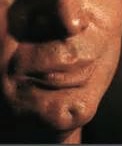What Type Of Chin Cleft Reduction Procedure Do I Need?
Q: Dr. Eppley, I am interested in chin cleft removal surgery. The deepest part of my cleft is at the very top. Ironically, the deepest part at the top goes down to the bone, which is not a valley but a peak at this part of the cleft. So the top is strictly due to the positioning of the attached muscle. The bone is grooved at the bottom of the chin with a 1/8th inch deep notch in the bone. This is basically the deepest possible cleft chin possible.
From what I’ve read, entering through the mouth to avoid scarring this is the best that can be done and will most likely not fully remove the cleft but dampen it. I would like to know how many cleft chin removals using subcutaneous fat as a filler with smoothing of the chin bone have you done?
 A: When it comes to chin cleft removal (or more accurately for many patients a chin cleft reduction), it is important to classify the type/depth of chin cleft. I classify chin clefts into four types based on the clefting seen in the skin, fat, muscle and bone levels. By your description and the example you have shown which corollates to your chin cleft, that would be a type IV chin cleft. When the chin cleft is this deep and the skin edges are deeply inverted, placing a filler material in the cleft is really not the best treatment. The tissues are so deeply indented that it will resist any ‘soft’ push from any underlying augmentation in the soft tissue layer. Augmentation of the bone, although reasonable to do, has the less effect on Type III and IV chin clefts. The most effective treatment in Type IV chin clefts is external excision and multiple layer reapproximation to level out the clefted tissues all the way down to bone. While this is the best approach in very deep chin clefts, this creates an external scar which is rarely aesthetically acceptable. Thus one has to accept an internal intraoral approach with a much reduced result. If done intraorally, the bony cleft would be augmented, the skin released from the muscle and a dermal-fat graft placed underneath the released skin. I would expect maybe a 1/3 to 1/2 reduction in the Type IV chin cleft with this approach.
A: When it comes to chin cleft removal (or more accurately for many patients a chin cleft reduction), it is important to classify the type/depth of chin cleft. I classify chin clefts into four types based on the clefting seen in the skin, fat, muscle and bone levels. By your description and the example you have shown which corollates to your chin cleft, that would be a type IV chin cleft. When the chin cleft is this deep and the skin edges are deeply inverted, placing a filler material in the cleft is really not the best treatment. The tissues are so deeply indented that it will resist any ‘soft’ push from any underlying augmentation in the soft tissue layer. Augmentation of the bone, although reasonable to do, has the less effect on Type III and IV chin clefts. The most effective treatment in Type IV chin clefts is external excision and multiple layer reapproximation to level out the clefted tissues all the way down to bone. While this is the best approach in very deep chin clefts, this creates an external scar which is rarely aesthetically acceptable. Thus one has to accept an internal intraoral approach with a much reduced result. If done intraorally, the bony cleft would be augmented, the skin released from the muscle and a dermal-fat graft placed underneath the released skin. I would expect maybe a 1/3 to 1/2 reduction in the Type IV chin cleft with this approach.
One simple test to determine how much a chin cleft can be reduced, a saline or synthetic injectable filler treatment can be done in the office. If reasonably successful that would indicate that soft tissue filling would be reasonable to do. One could then proceed with either fat injections or a longer lasting more robust filler like Juvederm Voluma for treatment. If unsuccessful, then one knows that a more invasive procedure as I have described above would be needed.
Dr. Barry Eppley
Indianapolis, Indiana

North Meridian Medical Building
Address:
12188-A North Meridian St.
Suite 310
Carmel, IN 46032
Contact Us:
Phone: (317) 706-4444
WhatsApp: (317) 941-8237
